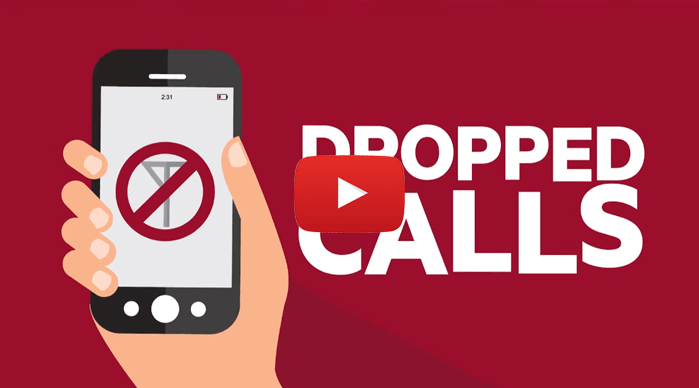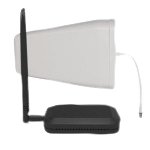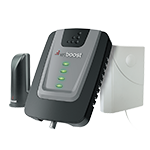How To Boost Cell Phone Signal In Apartments
Nobody wants to struggle with dropped calls, failed texts, and slow data from the comfort of their apartment. Unfortunately, poor cell service in apartments is very common.
Whether you're in an apartment with bad cell reception or struggling to find one with good cell reception, we have great news. There are different ways to boost cell phone signal in apartments. Keep reading to find out how.
We fix poor cell phone signal! Find the right signal booster for you:




What Causes Poor Cell Signal in Apartments?
Bad cell service in apartments is usually the result of a combination of the following three factors:
- Cell Tower Distance - The further your carrier's cell tower is from your apartment complex, the weaker the signal you receive.
- Building Material - Steel, concrete, brick, plaster, drywall, low-e glass, and everything in between the thick walls, diminish or block incoming cellular signals.
- Exterior Obstacles - Surrounding barriers, like buildings, trees, hills, and the like, disrupt reception.
Best Way to Boost Cell Signal in Your Apartment
The most reliable way to boost cellular service inside your apartment is with a cell phone signal booster.
Cell phone signal boosters for apartments:
- Capture existing 5G (on select frequencies), 4G, and LTE signals,
- Amplify them,
- Re-broadcast boosted cell signal inside.

They bypass building materials and communicate with distant cell towers, overcoming most cellular signal challenges apartments face. You'll be able to enjoy better cellular reception and faster data.
We're a leading provider of weBoost cellular boosters. Our kits include a directional outdoor antenna, an amplifier, an indoor antenna, and coaxial cable. The outdoor antenna requires an outdoor installation and must point in the direction of your nearest cell tower.
Thus, before you buy, contact your apartment manager or landlord and ask about their outdoor antenna mounting regulations. Some will allow you to mount the antenna on the rail of your balcony, on a tripod mount placed on the balcony, or next to a window. If you have any questions, don't hesitate to call us at 1-800-568-2723.
With that being said, here are our top apartment cell signal booster recommendations:
Recommended Cell Signal Boosters for Apartments

The weBoost Home Studio will enhance cellular reception in small apartments for all cellular devices across all US carriers.
Under perfect conditions, it offers up to 1,500 sq ft of coverage. However, coverage is determined by how strong or weak your outside signal is. Apartments in weak signal areas will probably get around 200-500 sq ft, enough to cover one room.
The kit includes a yagi directional antenna and a small compact amplifier with an attached indoor antenna. It can easily be placed on a shelf, table, counter, or any flat surface.

Like the weBoost Home Studio, the weBoost Home Room is also rated to cover up to 1,500 sq ft with crisp cellular signals. The main difference is what's included in the kit.
The Home Room comes with a directional outdoor panel antenna and a desktop indoor antenna. This configuration enables a more flexible installation. Rather than having the indoor antenna with the amplifier, you're able to choose where to place it for optimal results.

Best for medium to large apartments, townhomes, and condos.
Add To CartThe weBoost Home MultiRoom is our most powerful cell phone booster for apartments. Though, it will also work for townhomes and condos.
With high gain and uplink power, it offers great amplification and reach to distant cell towers. Under best conditions, it can cover up to 5,000 sq ft. Most people, however, get between 2,000 to 3,000 sq ft. If you have extremely poor cell phone signal outside your apartment, the Home MultiRoom is your best bet for enhanced reception throughout.
The kit includes a powerful outdoor yagi antenna and a sleek fabric front panel antenna that'll fit any home décor. Featuring a kickstand, the indoor antenna is easy to install anywhere you need.
Are There Other Ways to Boost Cell Reception in Apartments?
Here are alternative solutions to improving cellular signal inside your apartment:
1) Get a Femtocell
A femtocell, is a device that takes your broadband connection and converts it into cellular, providing you with a localized cellular network. It’s like a mini personal cell tower powered by your internet router. Verizon calls their femtocell Network Extender, while ATT calls their Cell Booster.
However, they do have some disadvantages:
- They need a consistent broadband internet connection, such as cable, DSL, and fiber. They will not work with satellite internet.
- They can slow down your internet speed.
- They are carrier-specific. This means the femtocell will only work with the carrier the device was purchased from.
- They only support a certain number of devices at a time.
While femtocells are good options to improve your cellular connection, in the long run, a femtocell is no match for a signal booster when it comes to consistent coverage and price.
2) Enable WiFi Calling
WiFi calling lets you talk and text over an active WiFi network. If you have a decent WiFi connection throughout your apartment, WiFi calling is a great option. It will allow you to talk and text in areas where cellular coverage is limited or unavailable.
- Samsung Phones: Settings → Connections → Tap WiFi Calling to enable
- Other Android Phones: Settings → Networks & Internet → Advanced → Tap WiFi Calling to Enable
- iPhones: Settings → Cellular → Tap WiFi Calling to Enable
You could also use apps like Google Voice that enable internet-based communication.
Keep in mind, though, that talking and texting over WiFi can overload and strain your network. Also, the reliability of your connection is only as strong as your WiFi. If your network is slow or goes down, so will your service.
For a dependable, consistent signal, strongly consider a signal booster. They can help offload congestion from your WiFi, as well as enhance your overall cellular service without affecting your broadband connection. Plus, in the event your internet goes out, you’ll still have a way to stay connected.
3) Try Bluetooth Headphones or Headsets
Is there a specific spot in your apartment that gets a decent signal? If yes, you can leave your device there and connect your Bluetooth headphones or headset.
As long as you're within range, you're able to roam your apartment and still take phone calls without dropping them and stream music without buffering. While it can be a tad inconvenient, it's a great temporary fix for poor cell reception.
Contact Us For Better Cell Signal in Your Apartment
Wilson Amplifiers is a leading provider of home, office, and vehicle cellular signal boosters. They amplify 4G, LTE, and 5G (on select frequencies) for all cellular devices across all cellular carriers. We’ve boosted cellular signals in countless of homes, buildings, and vehicles across America and Canada. We offer:
- Free consultation with our US-based customer support. Email us at sales@wilsonamplifiers.com) or call us at 1-800-568-2723 with any questions you may have.
- Free shipping. Usually ships the same day.
- 90-day (seriously) money back guarantee. You want to make sure you're satisfied.
Our goal is simple: keep people connected. Ask us anything and we'll be glad to help.
Interested in Learning More? Check Out Our Signal Boosting Info Center


Money Back Guarantee

Technical Support